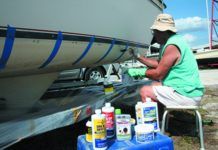IR Thermometers
I was surprised in your review of the Telatemp and Raytek Infrared Thermometers [see “Infrared Thermometers,” PS Oct. 15, ’04] that you didn’t test these instruments by pointing them at the surface of the sailing waters in your area. I’m curious to know how they respond for that purpose since the water surface seems to be shiny, and thus hard to measure as you stated in your report.
If it’s possible to use these devices this way, they would be very valuable in determining the varying temperatures in the vicinity of the Gulf Stream or a cold/warm zone for finding fish.
Stephen Kelley
San Diego, CA
That’s a good question, and the answer is a qualified yes: The infrared sensors do measure the temperature of water, but only at its surface. The sensor won’t penetrate beyond that, because it’s only surfaces that these devices work with. Even then, shiny surfaces are more challenging. In some instances it’s best to put a piece of tape on the object being measured, wait a moment, and then shoot the tape.
We tried a simple experiment to see how our Raytek infrared thermometer works with water. First we went to a local tidal river and measured the temperature at the surface, and then three feet down, using a Radio Shack digital thermometer fitted with an outdoor probe. (We duct-taped the probe to a rock to sink it down three feet.) The thermometer measured the temperature both at the surface and at three feet as 54.9 F. We then shot the water with the Raytek sensor. It registered 55.0-virtually identical to the thermometer. But we were interested to see if that reading was from right on the surface, or somewhere deeper.
We pocketed the rock, took it back to our office, and soaked it in very hot water for 10 minutes. Meanwhile we filled a bucket with cold water and took its temperature with the thermometer. It was 61.9 at 3 inches deep, and 63.9 right at the surface. Then we put the hot rock on the bottom and shot the water with the Raytek. It measured 64.0 all around the surface, and when we aimed it right at the hot rock, 8 inches down through the clear water, we still got 64.0. That matched the digital thermometer’s reading, so there was no apparent penetration.
Later, we reheated the rock and gauged its temperature-98-as we lowered it into the cold water. The second it went below the surface, the Raytek display changed to show the water surface temperature, 68.
Just for kicks, we reversed the experiment. We froze the rock, and meanwhile used the Raytek to measure the water with a floating ice cube in it. The Raytek registered 37 for the ice, and 64.5 for the water surrounding it. When the rock was cold through-and-through, we put it in the bucket and quickly shot it through the water. Again, there was no difference.
So it appears to us that the infrared sensor is quite accurate at measuring water temperature right at the surface, shiny though it may be. In the real world, of course, the temperature of water right at its interface with the air above it is often quite different from its temperature even a few inches down. So using this device to determine where the Gulf Stream is-or where the most advantageous fishing grounds are-won’t work as well as we would all like.
———-
Seeing in the Rain
Do you have suggestions for those of us who wear glasses while sailing in the rain? I need my glasses for both distance and reading; so I wear them all the time. When it rains, I’m pretty useless at the helm since my vision is clouded with drops on the lenses.
Sandy Donaldson
Via e-mail
We wear eyeglasses on the water as well, and the the worst possible scenario is driving rain. Not only do your lenses get spotted with drops, making them almost useless, but depending upon the temperature, they can also fog up. Because there doesn’t appear to be a ready-made product solution to this dilemma, we wear contact lenses at those times. That may not be possible for you. If not, try wearing a hat with a bill when it’s raining. If you can shield your face (and thus your eyeglasses) from the rain, you can prolong your uninhibited vision.
Another thing you can try, if you haven’t already is RainX; it’s a product sold for use on windshields to help raindrops bead up and fall off more quickly. We’ve had marginal success in the past with this on glasses.









































